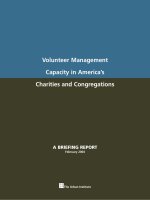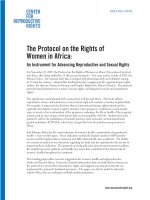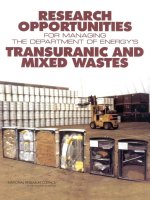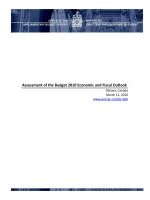Hitting America’s Soft Underbelly -The Potential Threat of Deliberate Biological Attacks Against the U.S. Agricultural and Food Industry pot
Bạn đang xem bản rút gọn của tài liệu. Xem và tải ngay bản đầy đủ của tài liệu tại đây (618.81 KB, 65 trang )
Hitting America’s
Soft Underbelly
The Potential Threat of
Deliberate Biological Attacks
Against the U.S. Agricultural
and Food Industry
PETER CHALK
Prepared for the Office of the Secretary of Defense
Approved for public release, distribution unlimited
The RAND Corporation is a nonprofit research organization providing
objective analysis and effective solutions that address the challenges
facing the public and private sectors around the world. RAND’s
publications do not necessarily reflect the opinions of its research clients
and sponsors.
R
®
is a registered trademark.
© Copyright 2004 RAND Corporation
All rights reserved. No part of this book may be reproduced in any form
by any electronic or mechanical means (including photocopying,
recording, or information storage and retrieval) without permission in
writing from RAND.
Published 2004 by the RAND Corporation
1700 Main Street, P.O. Box 2138, Santa Monica, CA 90407-2138
1200 South Hayes Street, Arlington, VA 22202-5050
201 North Craig Street, Suite 202, Pittsburgh, PA 15213-1516
RAND URL: />To order RAND documents or to obtain additional information, contact
Distribution Services: Telephone: (310) 451-7002;
Fax: (310) 451-6915; Email:
Library of Congress Cataloging-in-Publication Data
Chalk, Peter.
Hitting America’s soft underbelly : the potential threat of deliberate biological
attacks against the U.S. agricultural and food industry / Peter Chalk.
p. cm.
Includes bibliographical references.
“MG-135.”
ISBN 0-8330-3522-3 (pbk. : alk. paper)
1. Agriculture—Defense measures—United States. 2. Civil defense—United States.
3. Food industry and trade—Defense measures—United States. 4. Bioterrorism—
United States—Prevention. I.Title.
UA929.95.A35C49 2004
363.32—dc22
2003026834
The research described in this report was sponsored by the Office of
the Secretary of Defense (OSD). The research was conducted in the RAND
National Defense Research Institute, a federally funded research
and development center supported by the OSD, the Joint Staff,
the unified commands, and the defense agencies under Contract
DASW01-01-C-0004.
iii
Preface
Over the past decade, the United States has endeavored to increase its
ability to detect, prevent, and respond to terrorist threats and inci-
dents. This focus on protecting the country from attacks, which has
involved considerable financial outlays, has contributed to an in-
creasingly well-protected public infrastructure. Critical to this en-
deavor has been the development of vulnerability-threat analyses that
are designed to maximize both antiterrorist efforts and consequence
management procedures. Agriculture, however, has received compara-
tively little attention with respect to protection against terrorist inci-
dents. In terms of accurate threat assessments and consequence man-
agement procedures, the agriculture sector, and the food industry in
general, by and large has not been a part of the wide-ranging empha-
sis that has been given to critical infrastructure protection in the
United States.
This report aims to expand the current debate on domestic
homeland security by assessing the vulnerabilities of the agricultural
sector and the food chain to a deliberate act of biological terrorism.
The report begins with a discussion of the methods used to conduct
the analysis and the current state of research on threats to agricultural
livestock and produce. It then outlines agriculture’s importance to
the U.S. economy, assesses the vulnerabilities in the general food
industry, examines the capabilities that are needed to exploit those
vulnerabilities, and explores the likely outcomes from a successful at-
tack. The report next considers the question of why terrorists have yet
to employ agricultural assaults as a method of operation and con-
cludes with proposed recommendations for the U.S. policymaking
community.
iv Hitting America’s Soft Underbelly
The study should be of interest to policymakers concerned with
issues related to U.S. homeland security, critical infrastructure protec-
tion, and possible future terrorist uses of biological agents.
Research for this report was conducted within the Federal Re-
search Program, International Security and Defense Policy Center of
the RAND National Security Research Division (NSRD). NSRD
conducts research and analysis for a broad range of clients, including
the U.S. Department of Defense, allied foreign governments, the in-
telligence community, and foundations.
v
Contents
Preface iii
Tables
vii
Summary
ix
Acknowledgments
xv
Acronyms
xvii
CHAPTER ONE
Introduction 1
Research Methods
2
The Importance of the Agricultural Sector to the U.S. Economy
4
Organization of This Report
5
CHAPTER TWO
The Vulnerability of U.S. Agriculture to Bio-Attacks 7
Concentrated and Intensive Contemporary Farming Practices
7
Increased Susceptibility of Livestock to Disease
9
Insufficient Farm/Food-Related Security and Surveillance
10
Inefficient Passive Disease-Reporting System
11
Inappropriate Veterinarian and Diagnostic Training
13
A Focus on Aggregate Rather Than Individual Livestock Statistics
13
Capability Requirements for Carrying Out an Agroterrorist Attack
14
CHAPTER THREE
Potential Impact of a Major Act of Agroterrorism 19
Economic Disruption
19
Loss of Political Support and Confidence in the Government
22
Social Instability
25
vi Hitting America’s Soft Underbelly
Agroterrorism to Generate Financial Capital and as a Form of
Blackmail
27
Biological Assaults Against Agriculture and Terrorists’ Modus
Operandi
28
CHAPTER FOUR
Policy Recommendations 33
Bibliography
43
vii
Tables
2.1. Animal Pathogens with Potential to Severely Impact Agricultural
Populations
16
3.1. Culling Operations During the UK FMD Outbreak,
February–June 2001
23
3.2. Selected 20th-Century Agriculture and Food Bioterrorism
Incidents
29
4.1. Components of a National Strategy to Counter Biological Attacks
Against Agriculture
42
ix
Summary
The Importance of the U.S. Agricultural Industry and Its
Vulnerability to Disruption
Agriculture
1
and the food industry in general are enormously impor-
tant to the social, economic, and, arguably, political stability of the
United States. Although farming directly employs less than 3 percent
of the American population, one in eight people works in an occupa-
tion that is directly supported by food production. Agriculture’s share
of produce sold overseas is more than double that of other U.S. in-
dustries, which makes the sector a major component in the U.S. bal-
ance of trade.
Unfortunately, the agriculture and food industries are vulnerable
to deliberate (and accidental) disruption. Critical concerns in this area
include:
• The concentrated and intensive nature of contemporary U.S.
farming practices
• The increased susceptibility of livestock to disease
• A general lack of farm/food-related security and surveillance
• An inefficient, passive disease-reporting system that is further
hampered by a lack of trust between regulators and producers
• Veterinarian training that tends not to emphasize foreign animal
diseases (FADs) or large-scale husbandry
_____________
1
For the purposes of this report, agriculture refers to all activities included in the production
cycle of the entire food industry. Wholesalers and restaurant chains are included as related
entities that are directly dependent on the agriculture industry; they occupy the “supply” end
of the farm-to-table continuum.
x Hitting America’s Soft Underbelly
• A prevailing focus on aggregate, rather than individual, livestock
statistics
Although vulnerability does not equate to risk, and there are few
recorded instances of terrorists actually using disease against agricul-
ture, a realistic potential for disruption exists. Indeed, what makes the
vulnerabilities inherent in agriculture so worrying is that the capabil-
ity requirements for exploiting those weaknesses are not significant
and are certainly less considerable than those needed for a human-
directed bio-attack.
Several factors account for this situation. First, there is a large
menu of agents from which to choose, with no less than 15 “List A”
pathogens identified by the Office International des Epizooties (OIE)
as having the potential to severely effect agricultural populations
and/or trade. Most of these diseases are environmentally hardy—
being able to exist for extended periods of time on organic or inor-
ganic matter—and typically are not the focus of concerted livestock
vaccination programs in the United States.
Second, many FADs are non-zoonotic, meaning they cannot
“jump” the animal-human species barrier; as such, there is no risk of
latent or accidental (human) infection associated with these patho-
gens. Thus, the perpetrator is not required to have an advanced un-
derstanding of animal disease epidemiology and transmission modes,
nor is there any need for elaborate containment procedures, personal
protective equipment, and/or prophylaxis antibiotics in the prepara-
tion of the disease agent.
Third, animal diseases can be quickly spread to affect large
numbers of herds over wide geographic areas. This factor reflects the
intensive and concentrated nature of modern farming practices in the
United States and the increased susceptibility of livestock to viral and
bacterial infections. There is, in other words, no issue of weaponiza-
tion that needs to be addressed in agricultural terrorism because the
animals themselves are the primary vector for pathogenic transmis-
sion.
Fourth, if the objective is human deaths, the food chain offers a
low-tech mechanism that is nevertheless conducive to disseminating
Summary xi
toxins and bacteria. Developments in the farm-to-table food contin-
uum have greatly increased the number of entry points for these
agents. These openings for contaminants combined with the lack of
security and surveillance at many processing and packing plants, have
helped to substantially augment the technical ease of orchestrating a
food-borne attack.
The Impact of a Major Act of Agroterrorism
The impact of a major agricultural/food-related disaster in the United
States would be significant and could easily extend beyond the agri-
cultural community to affect other segments of society.
Perhaps one of the most immediate effects of a major act of
biological agroterrorism
2
would be economic disruption, generating
costs on at least three different levels. First, there would be direct
losses resulting from containment measures and the destruction of
disease-ridden livestock. Second, indirect multiplier effects would ac-
crue from compensation costs paid to farmers for the destruction of
agricultural commodities and losses suffered by both directly and in-
directly related industries. Finally, international costs would accu-
mulate in the form of protective trade embargoes imposed by major
external trading partners.
A successful act of agroterrorism could also undermine the do-
mestic confidence in and support of government. The release of con-
tagious pathogens against livestock or the contamination of the farm-
to-table continuum through the introduction of toxic or bacterial
agents could cause the public to question the safety of the food supply
and lead to speculation about the effectiveness of existing contingency
planning against weapons of mass destruction in general.
_____________
2
For the purposes of this report, agroterrorism is defined as the deliberate introduction of a
disease agent, either against livestock or into the food chain, for purposes of undermining so-
cioeconomic stability and/or generating fear. Depending on the disease agent and pathogenic
vector chosen, agroterrorism is a tactic that can be used either to cause mass socioeconomic
disruption or as a form of direct human aggression.
xii Hitting America’s Soft Underbelly
The mechanics of dealing with a major act of agroterrorism
could trigger additional public criticism. Mass eradication and dis-
posal of livestock in particular could be controversial, possibly elicit-
ing protests from affected farmers and animal rights and environ-
mental groups.
Beyond their immediate economic and political impact, bioter-
rorist assaults against agriculture and/or the food chain have the po-
tential to create social panic. Attacks that have a direct impact on
public health by causing human deaths and injuries could be expected
to have particularly unsettling effects. Terrorists could use the result-
ing fear and alarm to their advantage to create an overall atmosphere
of anxiety without actually having to carry out indiscriminate civilian-
directed attacks.
Policy Recommendations
The United States, more by luck than by design, has not experienced
the type of major agricultural or food-related disasters to which other
countries and polities, such as the United Kingdom, Malaysia, and
Taiwan, have been subjected in recent years. As a result, there is no
widespread recognition of either the potential threat or the conse-
quences of such an event taking place on American soil.
The United States ignores the continuing vulnerability of the
agricultural sector at its own peril. Policy reforms can, and indeed
should, be instituted to pursue a more aggressive and coordinated
strategy to secure the industry against deliberate attack. Such meas-
ures would have the ancillary benefit of augmenting overall response
and consequence-management efforts for dealing with naturally oc-
curring outbreaks of food contamination or disease in livestock.
These initiatives should (1) build on programs already under way; (2)
leverage existing federal, state, and local capabilities; and (3) involve
key customers, stakeholders, and partners.
At least six policy recommendations can be made for the short
and medium term:
Summary xiii
• First, a comprehensive needs analysis should be undertaken to
ascertain appropriate investment requirements for the federal
emergency management infrastructure.
• Second, a move must be made to increase the number of state
and local personnel who have the requisite skills to identify and
treat exotic FADs.
• Third, assessments of how to foster more-coordinated and stan-
dardized links between the U.S. agricultural and intelligence
communities should be undertaken.
• Fourth, attention needs to be directed to issues of law enforce-
ment and the use of forensic investigations to determine whether
disease outbreaks have been deliberately orchestrated or are the
result of naturally occurring phenomena.
• Fifth, the overall effectiveness of the passive (i.e., voluntary) dis-
ease reporting system needs to be revisited, especially in relation
to providing more consistency with indemnity payments to
compensate farmers for destroyed livestock and improving the
effectiveness of communication channels between agricultural
producers and regulators.
• Finally, surveillance, internal quality control, and emergency re-
sponse at food processing and packing plants need to be ad-
dressed and evaluated to weigh the immediate costs of improv-
ing biosecurity against the long-term benefits of instituting those
upgrades.
Over the longer term, additional effort should be directed to-
ward standardizing and streamlining food supply and agricultural
safety measures within the framework of a single, integrated strategy
that cuts across the missions and capabilities of federal, state, and lo-
cal agencies. An effort such as this would help to unify the patchwork
of largely uncoordinated bio-emergency preparedness and response
initiatives that presently exists in the United States. Integration of ag-
riculture and food safety measures would also serve to reduce jurisdic-
tional conflicts and eliminate unnecessary duplication of effort.
xv
Acknowledgments
The author wishes to express his thanks to all those who made this re-
search possible. I would especially like to acknowledge officials and
academics with the Agricultural Research Service (ARS), the Animal
and Plant Health Inspection Service (APHIS), the Food Safety In-
spection Service (FSIS), the California Department of Food and Ag-
riculture (CDFA), and the University of California, Davis, who were
willing to be interviewed for this study and who provided invaluable
background material and commentaries on the structure and vulner-
ability of the U.S. agricultural sector. (Names of individuals have
been deliberately omitted for purposes of confidentiality.)
A special debt of appreciation is also owed to Jack Riley, director
of RAND’s Public Safety and Justice research unit, and Terry Wil-
son, animal disease specialist with the U.S. Army Medical Research
Institute of Infectious Diseases at Fort Detrick in Frederick, Mary-
land, both of whom provided highly useful and insightful comments
on the draft version of this study.
Finally, I would like to thank RAND’s NSRD for its interest
and assistance in funding this study and the editor, Nancy DelFavero,
for all of her help on the final report.
Needless to say, any errors and omissions are the sole responsi-
bility of the author.
xvii
Acronyms
AHS African horse sickness (virus)
AI avian influenza
APHIS Animal and Plant Health Inspection Service
ARS Agriculture Research Service
ASF African swine fever
BSL biosafety level
BT Bluetongue (virus)
BTWC Biological and Toxin Weapons Convention
BW biological weapon
CDFA California Department of Food and Agriculture
CIA Central Intelligence Agency
CIP critical infrastructure protection
DIA Defense Intelligence Agency
END Exotic Newcastle Disease
ESA Emergency Supplementary Assistance
FAD foreign animal disease
FBI Federal Bureau of Investigation
FMD foot and mouth disease
FSIS Food Safety and Inspection Services
FY fiscal year
xviii Hitting America’s Soft Underbelly
GAO General Accounting Office
GDP gross domestic product
HACCP Hazard Analysis and Critical Control Points
LSD Lumpy skin disease (virus)
OIE Office International des Epizooties
PDD Presidential Decision Directive
PPE personal protective equipment
RP Rinderpest (virus)
RVF Rift Valley fever
SGP sheep and goat pox (viruses)
SVD Swine vesicular disease
UK United Kingdom
USDA U.S. Department of Agriculture
VS vesicular stomatitis
WNV West Nile Virus
1
CHAPTER ONE
Introduction
Over the past decade, the United States has endeavored to increase its
ability to detect, prevent, and respond to terrorist threats and inci-
dents. Much of this focus on augmenting homeland security, which
has involved considerable financial outlays, has been aimed at up-
grading the public infrastructure through the development of vulner-
ability threat analyses designed to maximize both anti-terrorism and
consequence management efforts.
Although many gaps remain in the United States government’s
overall strategy to mitigate domestic terrorism in the country, invest-
ments in incident preparedness, training, and response have contrib-
uted to the development of at least basic emergency management
command structures. These nascent efforts have incrementally ad-
dressed the scope of potential terrorist attacks, from conventional
bombings to more “exotic” biological, chemical, radiological, and nu-
clear incidents.
Agriculture
1
and food production and supply, however, are in-
dustries that have received comparatively little attention in the gen-
eral field of counterterrorism and homeland security. In terms of ac-
curate threat assessments and consequence management procedures,
the agricultural sector is somewhat of a latecomer to the growing em-
phasis on critical infrastructure protection (CIP) in the United States.
Indeed, agriculture was not originally included under the provisions
_____________
1
For the purposes of this report, agriculture refers to all activities included in the production
cycle of the entire food industry. Wholesalers and restaurant chains are included as related
entities that are directly dependent on the agriculture industry; they occupy the “supply” end
of the farm-to-table continuum.
2 Hitting America’s Soft Underbelly
of Presidential Decision Directive 63 (PDD-63), which specifies
critical “nodes” (i.e., systems) deemed to be vulnerable to terrorist at-
tack or disruption, and was incorporated as a specific component of
U.S. national counterterrorist strategy only after the September 11 at-
tacks on the Pentagon and World Trade Center in 2001.
2
Research Methods
The research for this study proceeded in five main stages:
First, a qualitative and conceptual framework for analyzing
threats to agriculture and the food chain in general was created, based
primarily on the author’s subject matter background and previous
writings.
3
Second, interviews were conducted with members of the U.S.
policy community to determine the specific makeup of the American
farm-to-table food continuum, the extent of agriculture’s interface
with current developments in national critical infrastructure protec-
_____________
2
In May 1998, the Clinton administration passed into law PDD-63 on Critical Infrastruc-
ture Protection. The initiative designates nine physical and cyber-based systems essential to
the minimum operations of the economy and government that are deemed vulnerable to
possible terrorist attack—banking and finance; transportation; electricity, gas, and oil; tele-
communications; emergency law enforcement; government services; emergency fire service;
public health service; and the water supply. It should be noted that “Agriculture and Food
Safety” is one of eight subgroups of the National Security Council’s Weapons of Mass De-
struction Preparedness Group, which was established in 1998 under Presidential Decision
Directive 62 (PDD-62), “Combating Terrorism.” The U.S. Department of Agriculture
(USDA) chairs the Agriculture and Food Safety subgroup. However, as Henry Parker notes,
the USDA is a relative latecomer to the national security and defense structure and presently
lacks sufficient visibility and influence to champion greater federal attention to countering
biological attacks against agriculture (which is, itself, invariably overshadowed by other ter-
rorism-related issues). See Henry Parker, Agricultural Bioterrorism: A Federal Strategy to Meet
the Threat, McNair Paper 65, Washington, D.C.: Institute for National Strategic Studies,
National Defense University, March 2002, p. 30. For details on PDD-63, see The White
House, White Paper, The Clinton Administration’s Policy on Critical Infrastructure Protection:
Presidential Decision Directive 63, Washington, D.C.: The White House, May 22, 1998.
3
For example, Peter Chalk, “Terrorism, Infrastructure Protection, and the Agricultural Sec-
tor,” testimony given before the Subcommittee on Oversight of Government Management,
Restructuring and the District of Columbia, United States Senate, Washington, D.C., Oc-
tober 10, 2001.
Introduction 3
tion, and factors that are contributing to the sector’s risk of being ex-
posed to deliberate disruption and sabotage.
Third, an agroterrorism
4
threat assessment was generated by
equating inherent weaknesses within the agriculture sector to the ca-
pability requirements that would be necessary for the effective exploi-
tation of the identified vulnerabilities. This matrix was then com-
pared with known operational thresholds that have been established
within the domain of human biowarfare.
Fourth, the costs and consequences of agricultural disasters were
delineated by examining real-life incidents that have occurred in
other parts of the world and by utilizing a taxonomy that measures
“seriousness” of an incident in terms of its impact on overall public
health, economic security, and political stability.
Finally, the principal findings from the primary fieldwork and
secondary research were integrated and incorporated into the initial
conceptual framework to generate a final report.
The general susceptibility of the agriculture and food industry to
bioterrorism is difficult to address in a systematic manner due to the
highly dispersed nature of the industry and because many of the risk
evaluations used to assess vulnerability cannot be validated empiri-
cally. Nonetheless, the analysis contained in this report is useful to
the extent that it highlights critical areas of weakness in the U.S. agri-
cultural infrastructure and the potential ramifications of a concerted
attack against the sector, which can be used to identify priority areas
for future research. In addition, this study helps to enrich a body of
work that, in comparison with literature on other areas of CIP, re-
mains relatively thin and limited in its scope.
5
_____________
4
For the purposes of this report, agroterrorism is defined as the deliberate introduction of a
disease agent, either against livestock or into the food chain, for purposes of undermining so-
cioeconomic stability and/or generating fear. Depending on the disease agent and pathogenic
vector chosen, agroterrorism is a tactic that can be used either to cause mass socioeconomic
disruption or as a form of direct human aggression.
5
Comprehensive analyses in the field of (deliberately orchestrated) biological threats to
agriculture and the food chain are currently limited to the following published and unpub-
lished works: Parker (2002); Paul Rogers, Simon Whitby, and Malcolm Dando, “Biological
Warfare Against Crops,” Scientific American, Vol. 280, No. 6, 1999; Norm Steele, U.S. Agri-
4 Hitting America’s Soft Underbelly
The Importance of the Agricultural Sector to the U.S.
Economy
Agriculture and the food industry in general are extremely important
to the social, economic, and, arguably, political stability of the United
States. Although farming directly employs less than 3 percent of the
American population, one in eight people works in an occupation
that is directly supported by food production.
6
Cattle and dairy farm-
ers alone earn between $50 billion and $54 billion a year through
meat and milk sales,
7
while roughly $50 billion in revenues are gener-
ated every year through farm-related exports.
In 2001, food production constituted 9.7 percent of the U.S.
gross domestic product (GDP), generating cash receipts in excess of
$991 billion.
8
The share of agricultural commodities sold overseas is
more than double the proportion of goods exported by other indus-
tries, an important and relevant factor in positively impacting Wash-
ington’s balance of trade.
9
Added to these fiscal benefits is a solid
______________________________________________________
cultural Productivity, Concentration, and Vulnerability to Biological Weapons, unclassified de-
fense intelligence assessment for the Department of Defense Futures Intelligence Program,
Washington, D.C., January 14, 2000; Agricultural Research Service, Econoterrorism, a.k.a.
Agricultural Bioterrorism or Asymmetric Use of Biological Weapons, unclassified briefing,
Washington, D.C.: U.S. Department of Agriculture, February 28, 2000; Simon Whitby and
Paul Rogers, “Anti-Crop Biological Warfare—Implications of the Iraqi and US Programs,”
Defense Analysis, Vol. 13, No. 3, 1997; Terry Wilson et al., “A Review of Agroterrorism,
Biological Crimes and Biological Warfare Targeting Animal Agriculture,” APHIS, Fort
Detrick, Md., unpublished draft manuscript, 2001; John Gordon and Steen Bech-Nielsen,
“Biological Terrorism: A Direct Threat to Our Livestock Industry,” Military Medicine, Vol.
151, No. 7, 1986; and Agricultural Research Service, Agriculture’s Defense Against Biological
Warfare and Other Outbreaks, Washington, D.C.: USDA, December 1961.
6
Agricultural Research Service, “Econoterrorism, a.k.a. Agricultural Bioterrorism or Asym-
metric Use of Bioweapons,” unclassified briefing before the United States Department of Ag-
riculture, Washington, D.C., February 28, 2000. See also Parker (2002), p. 11.
7
Overall livestock sales in 2001 were in excess of $108 billion. See “Agro-Terrorism Still a
Credible Threat,” The Wall Street Journal, December 26, 2001.
8
Bureau of Economic Analysis, “Gross Domestic Product: First Quarter 2002 (Advance),”
(available at />9
Ellen Shell, “Could Mad Cow Disease Happen Here?” The Atlantic Monthly, Vol. 282,
No. 3, 1998, p. 92; “Stockgrowers Warned of Terrorism Threat,” The Chieftain, August 19,
1999.
Introduction 5
foundation of agricultural research and development, which has
helped to make U.S. farming the most efficient and productive in the
world. Consequently, Americans spend less than 11 percent of their
disposable income on food, compared with a global average of around
20 to 30 percent.
10
Although they are significant, these figures represent only a frac-
tion of the total value of agriculture to the U.S. economy. This is be-
cause the statistics do not take into account allied industries and
services, such as suppliers, transporters, distributors, and restaurant
chains.
11
The fiscal downstream effect of a major act of sabotage
against the food industry would, in other words, be multidimen-
sional, reverberating through other sectors of the U.S. economy and
ultimately impacting directly on the American consumer.
Organization of This Report
The remainder of this report aims to expand the current debate on
domestic homeland security by assessing the vulnerabilities of the ag-
ricultural and food industries to a deliberate act of biological terror-
ism. First, I outline the major vulnerabilities that exist in the agricul-
tural sector and assess the capabilities that are needed to exploit those
weaknesses. Next, I consider the likely outcomes of a successful agro-
terrorist attack and address the question of why terrorists have yet to
employ agricultural assaults as a method of operation. I conclude the
report with proposed recommendations for the U.S. policymaking
community.
_____________
10
Wilson et al. (2001), p. 22.
11
Parker (2002), p. 11. According to the Department of Commerce, the economic multi-
plier effect of exported farm commodities alone is in the region of 20 to 1.
7
CHAPTER TWO
Vulnerability of U.S. Agriculture to Bio-Attacks
For a variety of reasons, the U.S. agricultural and food industry re-
mains at risk to disruption and sabotage from deliberate bio-attacks.
The sector’s vulnerabilities principally stem from six factors:
• Concentrated and intensive contemporary farming practices in
the United States
• Increased susceptibility of livestock to disease
• A general lack of farm/food-related security and surveillance
• An inefficient, passive disease-reporting system that is further
hampered by a lack of trust between regulators and producers
• Veterinarian training that tends not to emphasize foreign animal
diseases (FADs) or large-scale husbandry
• A prevailing focus on aggregate, rather than individual, livestock
statistics.
Each of these factors is discussed in more detail in this chapter.
Concentrated and Intensive Contemporary Farming
Practices
Agriculture is a large-scale and intensive business in the United States.
Most dairies in the country can be expected to house at least 1,500
lactating cows at any one time, with some of the largest facilities con-









